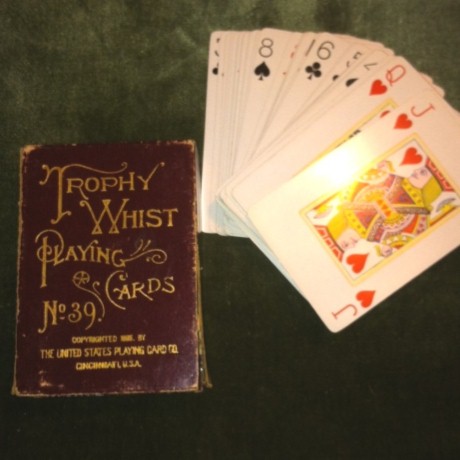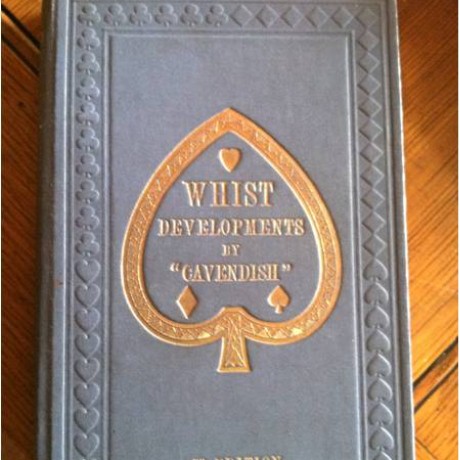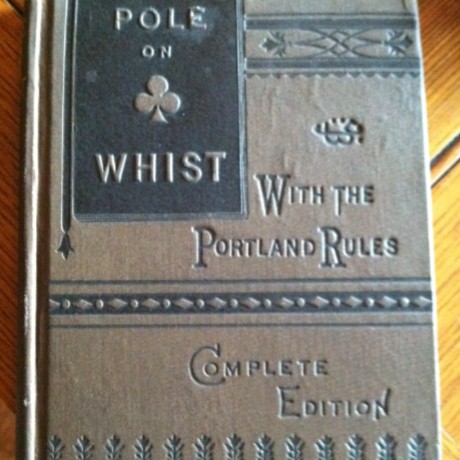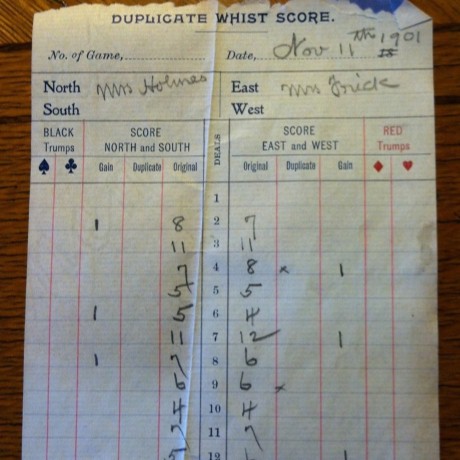Feeling Whistful?
We recently posted about Gilded Age games for children, but what about for adults? Parlor games of all kinds were popular, and a favorite card game in the late 1800s and early 1900s was whist. The Fricks were avid players of whist, which a forerunner of the 20th century favorite, bridge. It’s not at all difficult to learn or teach to family and friends, and once you do, let the vintage game tournaments begin!

A Brief Whistory
Whist is an English trick-taking card game which grew out of the earlier game ruff and honours. Its name comes from the obsolete adjective “whist” (a root of the word “wistful”) meaning quiet, silent, and/or attentive, which is exactly the way the game is to be played.

By the early 20th century, bridge, which shares many elements with whist, began to replace whist as the most popular card game. The name for bridge actually came from Russian whist, which was called biritch (pronounced ber-rich) and then was adapted by English speakers to the closest-sounding English word—bridge. While bridge was played with increasing popularity into the 20th century, whist fell out of favor in the United States, although the variant bid whist is still somewhat popular. Whist continues to be played in Great Britain, often in local tournaments called whist drives.

So, now that you have the basics, why not learn to play and start up a whist drive yourself!
The Rules of Whist
Number of Players
Four people can play in partnerships of two against two.
THE PACK
The standard 52-card pack is used. As in many bridge games, two packs of cards of contrasting back design are recommended. While one pack is being dealt, the other can be shuffled for the next deal.
RANK OF CARDS
A (high), K, Q, J, 10, 9, 8, 7, 6, 5, 4, 3, 2. (In drawing for partners and deal, however, ace is low.)
THE DEAL
The dealer gives each player one card at a time, face down, beginning with the player on his left, until he comes to the last card. The last card is the trump card.
THE TRUMP CARD
The dealer places the last card of the pack face up on the table before him, and every card of its suit becomes a trump. When it is the dealer's turn to play to the first trick, he picks up the trump card and it becomes part of the dealer's hand.
OBJECT OF THE GAME
Each of the partnerships tries to score points by taking any trick in excess of six. The partnership with the most points at the end of play wins the game.
THE PLAY
The turn to play is in clockwise rotation. The player on the dealer's left leads first and may play any card. Each player in turn plays a card, following suit if possible. If he cannot follow suit, a player may play any card. Four cards played (including the card led) constitute a trick.
A trick is won by the person who played the highest trump. Any trick not containing a trump is won by the person who played the highest card of the suit led. The winner of each trick leads next.
HOW TO KEEP SCORE
Each odd trick (a trick in excess of six) counts one point for the side winning it.

Whist Rules courtesy of Bicycle Cards
Whist is an English trick-taking card game which grew out of the earlier game ruff and honours. Its name comes from the obsolete adjective “whist” (a root of the word “wistful”) meaning quiet, silent, and/or attentive, which is exactly the way the game is to be played.
By the early 20th century, bridge, which shares many elements with whist, began to replace whist as the most popular card game. The name for bridge actually came from Russian whist, which was called biritch (pronounced ber-rich) and then was adapted by English speakers to the closest-sounding English word—bridge. While bridge was played with increasing popularity into the 20th century, whist fell out of favor in the United States, although the variant bid whist is still somewhat popular. Whist continues to be played in Great Britain, often in local tournaments called whist drives.
So, now that you have the basics, why not learn to play and start up a whist drive yourself!
The Rules of Whist
Number of Players
Four people can play in partnerships of two against two.
THE PACK
The standard 52-card pack is used. As in many bridge games, two packs of cards of contrasting back design are recommended. While one pack is being dealt, the other can be shuffled for the next deal.
RANK OF CARDS
A (high), K, Q, J, 10, 9, 8, 7, 6, 5, 4, 3, 2. (In drawing for partners and deal, however, ace is low.)
THE DEAL
The dealer gives each player one card at a time, face down, beginning with the player on his left, until he comes to the last card. The last card is the trump card.
THE TRUMP CARD
The dealer places the last card of the pack face up on the table before him, and every card of its suit becomes a trump. When it is the dealer's turn to play to the first trick, he picks up the trump card and it becomes part of the dealer's hand.
OBJECT OF THE GAME
Each of the partnerships tries to score points by taking any trick in excess of six. The partnership with the most points at the end of play wins the game.
THE PLAY
The turn to play is in clockwise rotation. The player on the dealer's left leads first and may play any card. Each player in turn plays a card, following suit if possible. If he cannot follow suit, a player may play any card. Four cards played (including the card led) constitute a trick.
A trick is won by the person who played the highest trump. Any trick not containing a trump is won by the person who played the highest card of the suit led. The winner of each trick leads next.
HOW TO KEEP SCORE
Each odd trick (a trick in excess of six) counts one point for the side winning it.
Whist Rules courtesy of Bicycle Cards




